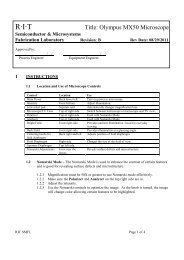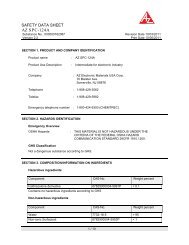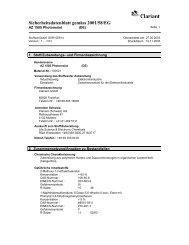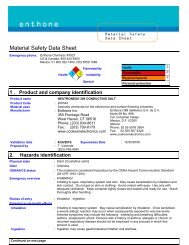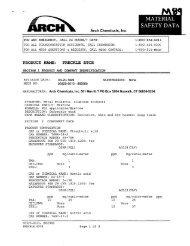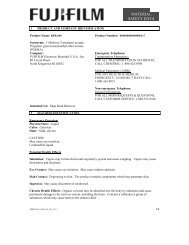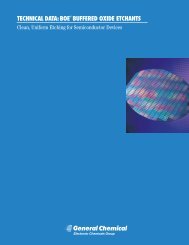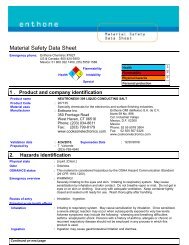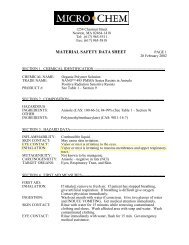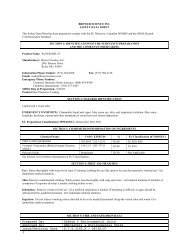0 2 0 Material Safety Data Sheet - SMFL
0 2 0 Material Safety Data Sheet - SMFL
0 2 0 Material Safety Data Sheet - SMFL
- No tags were found...
You also want an ePaper? Increase the reach of your titles
YUMPU automatically turns print PDFs into web optimized ePapers that Google loves.
Check for and remove any contact lenses. In case of contact, immediately flush eyes with plenty of water for at least 15minutes. Get medical attention if irritation occurs.Skin Contact:In case of contact, immediately flush skin with plenty of water for at least 15 minutes while removing contaminated clothingand shoes. Cover the irritated skin with an emollient. Wash clothing before reuse. Thoroughly clean shoes before reuse. Getmedical attention.Serious Skin Contact: Not available.Inhalation:If inhaled, remove to fresh air. If not breathing, give artificial respiration. If breathing is difficult, give oxygen. Get medicalattention.Serious Inhalation: Not available.Ingestion:Do NOT induce vomiting unless directed to do so by medical personnel. Never give anything by mouth to an unconsciousperson. If large quantities of this material are swallowed, call a physician immediately. Loosen tight clothing such as a collar,tie, belt or waistband.Serious Ingestion: Not available.Flammability of the Product: Non-flammable.Auto-Ignition Temperature: Not applicable.Flash Points: Not applicable.Flammable Limits: Not applicable.Products of Combustion: Not available.Section 5: Fire and Explosion <strong>Data</strong>Fire Hazards in Presence of Various Substances: Not applicable.Explosion Hazards in Presence of Various Substances:Risks of explosion of the product in presence of mechanical impact: Not available. Risks of explosion of the product inpresence of static discharge: Not available.Fire Fighting Media and Instructions:Flammable solid. SMALL FIRE: Use DRY chemical powder. LARGE FIRE: Use water spray or fog. Cool containing vesselswith water jet in order to prevent pressure build-up, autoignition or explosion.Special Remarks on Fire Hazards: <strong>Material</strong> in powder form, capable of creating a dust explosion. This material is flammablein powder form only.Special Remarks on Explosion Hazards:<strong>Material</strong> in powder form, capable of creating a dust explosion. Mixtures containing Potassium Perchlorate with Nickel &Titanium powders & infusorial earth can explode. Adding 2 or 3 drops of approximately 90% peroxyformic acid to powderednickel will result in explosion. Powdered nickel reacts explosively upon contact with fused ammonium nitrate at temperaturesbelow 200 deg. C.Section 6: Accidental Release MeasuresSmall Spill:Use appropriate tools to put the spilled solid in a convenient waste disposal container. Finish cleaning by spreading water onthe contaminated surface and dispose of according to local and regional authority requirements.Large Spill:Use a shovel to put the material into a convenient waste disposal container. Finish cleaning by spreading water on thecontaminated surface and allow to evacuate through the sanitary system. Be careful that the product is not present at aconcentration level above TLV. Check TLV on the MSDS and with local authorities.p. 2
Section 7: Handling and StoragePrecautions:Keep locked up.. Do not breathe dust. Wear suitable protective clothing. In case of insufficient ventilation, wear suitablerespiratory equipment. If you feel unwell, seek medical attention and show the label when possible. Keep away fromincompatibles such as oxidizing agents, combustible materials, metals, acids.Storage: Keep container tightly closed. Keep container in a cool, well-ventilated area.Section 8: Exposure Controls/Personal ProtectionEngineering Controls:Use process enclosures, local exhaust ventilation, or other engineering controls to keep airborne levels below recommendedexposure limits. If user operations generate dust, fume or mist, use ventilation to keep exposure to airborne contaminantsbelow the exposure limit.Personal Protection: <strong>Safety</strong> glasses. Lab coat. Dust respirator. Be sure to use an approved/certified respirator or equivalent.Gloves.Personal Protection in Case of a Large Spill:Splash goggles. Full suit. Dust respirator. Boots. Gloves. A self contained breathing apparatus should be used to avoidinhalation of the product. Suggested protective clothing might not be sufficient; consult a specialist BEFORE handling thisproduct.Exposure Limits:TWA: 1 (mg/m3) from ACGIH (TLV) [United States] Inhalation Respirable. TWA: 0.5 (mg/m3) [United Kingdom (UK)] TWA: 1(mg/m3) from OSHA (PEL) [United States] InhalationConsult local authorities for acceptable exposure limits.Section 9: Physical and Chemical PropertiesPhysical state and appearance: Solid. (Metal solid. Lustrous solid.)Odor: Odorless.Taste: Not available.Molecular Weight: 58.71 g/moleColor: Silvery.pH (1% soln/water): Not applicable.Boiling Point: 2730°C (4946°F)Melting Point: 1455°C (2651°F)Critical Temperature: Not available.Specific Gravity: Density: 8.908 (Water = 1)Vapor Pressure: Not applicable.Vapor Density: Not available.Volatility: Not available.Odor Threshold: Not available.Water/Oil Dist. Coeff.: Not available.Ionicity (in Water): Not available.Dispersion Properties: Not available.Solubility:p. 3
Insoluble in cold water, hot water. Insoluble in Ammonia. Soluble in dilute Nitric Acid. Slightly soluble in Hydrochloric Acid,Sulfuric Acid.Stability: The product is stable.Instability Temperature: Not available.Conditions of Instability: Incompatible materialsSection 10: Stability and Reactivity <strong>Data</strong>Incompatibility with various substances: Reactive with oxidizing agents, combustible materials, metals, acids.Corrosivity: Non-corrosive in presence of glass.Special Remarks on Reactivity:Incompatible with strong acids, selenium, sulfur, wood and other combustibles, nickel nitrate, aluminum, aluminum trichloride,ethylene, p-dioxan, hydrogen, methanol, non-metals, oxidants, sulfur compounds, aniline, hydrogen sulfide, flammablesolvents, hydrazine, and metal powders (especially zinc, aluminum, and magnesium), ammonium nitrate, nitryl fluoride,bromine pentafluoride, potassium perchlorate + titanium powder + indusorial earth.Special Remarks on Corrosivity: Not available.Polymerization: Will not occur.Routes of Entry: Inhalation. Ingestion.Toxicity to Animals:LD50: Not available. LC50: Not available.Section 11: Toxicological InformationChronic Effects on Humans:CARCINOGENIC EFFECTS: Classified 2B (Possible for human.) by IARC. Classified 2 (Some evidence.) by NTP. Causesdamage to the following organs: skin. May cause damage to the following organs: kidneys, lungs, liver, upper respiratory tract.Other Toxic Effects on Humans:Hazardous in case of inhalation. Slightly hazardous in case of skin contact (irritant, sensitizer), of ingestion.Special Remarks on Toxicity to Animals:Lowest Published Lethal Dose/Conc: LDL [Rat] - Route: Oral; Dose: 5000 mg/kg LDL [Guinea Pig] - Route: Oral; Dose: 5000mg/kgSpecial Remarks on Chronic Effects on Humans: May cause cancer based on animal test dataSpecial Remarks on other Toxic Effects on Humans:Acute Potential Health Effects: Skin: Nickel dust and fume can irritate skin. Eyes: Nickel dust and fume can irritate eyes.Inhalation: Inhalation of dust or fume may cause respiratory tract irritation with non-productive cough, hoarseness, sore throat,headache, vertigo, weakness, chest pain, followed by delayed effects, including tachypnea, dyspnea, and ARDS. Death dueto ARDS has been reported following inhalation of high concentrations of respirable metallic nickel dust. Later effects mayinclude pulmonary edema and fibrosis. Ingestion: Metallic nickel is generally considered not to be acutely toxic if ingested.Ingestion may cause nausea, vomiting, abdominal , and diarrhea. Nickel may damage the kidneys(proteinuria), and mayaffect liver function. It may also affect behavior (somnolence), and cardiovascular system (increased cornary artery resistance,decreased myocardial contractility, myocardial damage, regional or general arteriolar or venus dilation). Chronic PotentialHealth Effects: Skin: May cause skin allergy. Nickel and nickel compounds are among the most common sensitizers inducingallergic contact dermatitis. Inhalation: Chronic inhalation nickel dust or fume can cause chronic hypertrophic rhinitis, sinusitis,nasal polyps, perforation of the nasal septum, chronic pulmonary irritation, fibrosis, pulmonary edema, pulmonary eosinophilia,Pneumoconiosis, allergies (asthma-like allergy), and cancer of the nasal sinus cavities, lungs, and possibly other organs.Future exposures can cause asthma attacks with shortness of breath, wheezing, cough, and/or chest tightness. Chronicinhalation of nickel dust or fume may also affect the liver (impaired liver function tests), and blood (changes in red bloodcell count). Ingestion: Prolonged or repeated ingestion of nickel can be a source chronic urticaria and other signs of allergy.p. 4
Chronic ingestion of NIckel may also affect respiration and cause pneumoconiosis or fibrosis. Note: In the general population,sensitization occurs from exposure to nickel-containing coins, jewelry, watches,Ecotoxicity: Not available.BOD5 and COD: Not available.Section 12: Ecological InformationProducts of Biodegradation:Possibly hazardous short term degradation products are not likely. However, long term degradation products may arise.Toxicity of the Products of Biodegradation: The products of degradation are as toxic as the original product.Special Remarks on the Products of Biodegradation: Not available.Section 13: Disposal ConsiderationsWaste Disposal:Waste must be disposed of in accordance with federal, state and local environmental control regulations.Section 14: Transport InformationDOT Classification: Not a DOT controlled material (United States).Identification: Not applicable.Special Provisions for Transport: Not applicable.Section 15: Other Regulatory InformationFederal and State Regulations:California prop. 65: This product contains the following ingredients for which the State of California has found to cause cancer,birth defects or other reproductive harm, which would require a warning under the statute: Nickel metal California prop. 65:This product contains the following ingredients for which the State of California has found to cause cancer which would requirea warning under the statute: Nickel metal Connecticut hazardous material survey.: Nickel metal Illinois toxic substancesdisclosure to employee act: Nickel metal Illinois chemical safety act: Nickel metal New York release reporting list: Nickel metalRhode Island RTK hazardous substances: Nickel metal Pennsylvania RTK: Nickel metal Michigan critical material: Nickelmetal Massachusetts RTK: Nickel metal Massachusetts spill list: Nickel metal New Jersey: Nickel metal New Jersey spill list:Nickel metal Louisiana spill reporting: Nickel metal California Director's List of Hazardous Substances: Nickel metal TSCA 8(b)inventory: Nickel metalOther Regulations:OSHA: Hazardous by definition of Hazard Communication Standard (29 CFR 1910.1200). EINECS: This product is on theEuropean Inventory of Existing Commercial Chemical Substances.Other Classifications:WHMIS (Canada): CLASS D-2A: <strong>Material</strong> causing other toxic effects (VERY TOXIC).DSCL (EEC):R40- Possible risks of irreversible effects. R43- May cause sensitization by skin contact. S22- Do not breathe dust. S36- Wearsuitable protective clothing.HMIS (U.S.A.):Health Hazard: 2Fire Hazard: 0p. 5
Reactivity: 0Personal Protection: ENational Fire Protection Association (U.S.A.):Health: 2Flammability: 0Reactivity: 0Specific hazard:Protective Equipment:Gloves. Lab coat. Dust respirator. Be sure to use an approved/certified respirator or equivalent. Wear appropriate respiratorwhen ventilation is inadequate. <strong>Safety</strong> glasses.References: Not available.Other Special Considerations: Not available.Created: 10/10/2005 08:42 PMLast Updated: 11/01/2010 12:00 PMSection 16: Other InformationThe information above is believed to be accurate and represents the best information currently available to us. However, wemake no warranty of merchantability or any other warranty, express or implied, with respect to such information, and we assumeno liability resulting from its use. Users should make their own investigations to determine the suitability of the information fortheir particular purposes. In no event shall ScienceLab.com be liable for any claims, losses, or damages of any third party or forlost profits or any special, indirect, incidental, consequential or exemplary damages, howsoever arising, even if ScienceLab.comhas been advised of the possibility of such damages.p. 6



